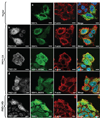Protein kinase D1 regulates cofilin-mediated F-actin reorganization and cell motility through slingshot
- PMID: 19329994
- PMCID: PMC2761768
- DOI: 10.1038/ncb1861
Protein kinase D1 regulates cofilin-mediated F-actin reorganization and cell motility through slingshot
Abstract
Dynamic actin remodelling processes at the leading edge of migrating tumour cells are concerted events controlled by a fine-tuned temporal and spatial interplay of kinases and phosphatases. Actin severing is regulated by actin depolymerizing factor (ADF)/cofilin, which regulates stimulus-induced lamellipodia protrusion and directed cell motility. Cofilin is activated by dephosphorylation through phosphatases of the slingshot (SSH) family. SSH activity is strongly increased by its binding to filamentous actin (F-actin); however, other upstream regulators remain unknown. Here we show that in response to RhoA activation, protein kinase D1 (PKD1) phosphorylates the SSH enzyme SSH1L at a serine residue located in its actin-binding motif. This generates a 14-3-3-binding motif and blocks the localization of SSH1L to F-actin-rich structures in the lamellipodium by sequestering it in the cytoplasm. Consequently, expression of constitutively active PKD1 in invasive tumour cells enhanced the phosphorylation of cofilin and effectively blocked the formation of free actin-filament barbed ends and directed cell migration.
Figures














References
-
- Bamburg JR, McGough A, Ono S. Putting a new twist on actin: ADF/cofilins modulate actin dynamics. Trends Cell Biol. 1999;9:364–370. - PubMed
-
- Pollard TD, Borisy GG. Cellular motility driven by assembly and disassembly of actin filaments. Cell. 2003;112:453–465. - PubMed
-
- Mouneimne G, et al. Spatial and temporal control of cofilin activity is required for directional sensing during chemotaxis. Curr Biol. 2006;16:2193–2205. - PubMed
-
- Sinha P, et al. Increased expression of epidermal fatty acid binding protein, cofilin, and 14-3-3-sigma (stratifin) detected by two-dimensional gel electrophoresis, mass spectrometry and microsequencing of drug-resistant human adenocarcinoma of the pancreas. Electrophoresis. 1999;20:2952–2960. - PubMed
Publication types
MeSH terms
Substances
Grants and funding
LinkOut - more resources
Full Text Sources
Other Literature Sources
Molecular Biology Databases
Research Materials

